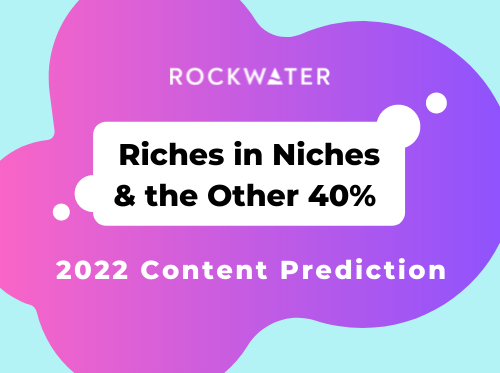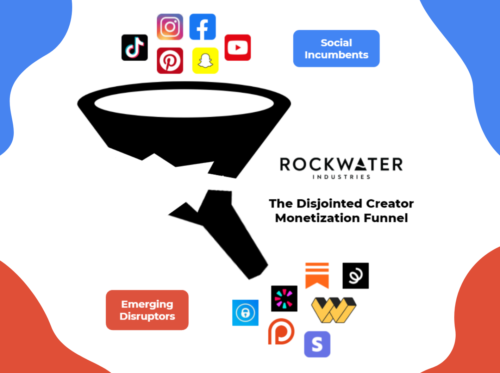2021 Year In Review: Sticky Acceleration and Birth of the “Ownership Economy”
2021 was the year acceleration stuck. It was also the year in which the “passion economy” gave birth to the “ownership economy”.
But it’s impossible to characterize 2021 without the context of 2020.
Last year, for our 2020 year-in-review report we used two words to describe that notorious year: acceleration and passion.
Here’s an excerpt:
In 2020 the evolution from the “attention economy” accelerated into the “passion economy”.
Traditional media models that exemplify the “attention economy” seek to aggregate the broadest possible audience and monetize it by selling their attention to advertisers. However, as new technologies and platforms continue to proliferate the consumer ecosystem, the collective user attention fragments, diminishing the potential for audience scale that the “attention economy” was built on (or at least redistributing that audience into the hands of a few increasingly powerful tech companies).
But disruption is a double-edged sword.
These same technologies and platforms that are making it more challenging than ever for brands and creators to succeed through traditional models, are also empowering them to succeed through a whole new paradigm, which we call “the passion economy”. It’s nearly impossible for most brands, creators, or platforms to reach audiences as widely as they used to, but they can now go deeper with their fans than ever before.
For the brands, creators, and platforms that “own their audience”, the sky’s the limit in today’s “passion economy”.
With direct-to-consumer products, services, experiences, subscriptions, content, and so much more, as well as other derivative revenues such as brand and content licensing, syndication, and even advertising, the creators and platforms that have a deep enough connection with their fans to influence their behavior are becoming more valuable by the day. While those that merely “reach” their audience lose value as consumers find alternative digital destinations to immerse themselves in.
This year’s stay-at-home orders forced the mass abandonment of many traditional consumer habits and the mass adoption of emergent digital experiences. As a result, the legacy operators that were already facing headwinds had their blind spots further exposed, accelerating their decline as users fled for more delightful experiences. And the companies that were building towards a fan-first digital future grew their user bases significantly as new audiences began to build habits with them.
Virtual this.
At-home that.
Institutions that once felt so commonplace (gyms, movie theaters, concerts) now feel retro, and concepts that once felt so futuristic (e-learning, virtual fitness and performances) now feel commonplace.
Over the last 10 months, we’ve seen the levels of user adoption and habit formation on transformative digital platforms that we were expecting to see over the next several years.
- 73% of consumers are now streaming more OTT video content than they were before the pandemic.
- 59% are spending more time on online gaming platforms.
- 52% are listening to more podcasts.
- Weekly active consumption of streaming fitness content has increased by 77%.
- E-commerce sales grew by 32%.
- Online food deliveries grew by over 100% ($5.5 billion spent across the 4 top food delivery platforms since April).
- Creator-driven “micro DTC” marketplaces entered the mainstream: Cameo grew its bookings by 350% and its GMV by 4.5X, while Only Fans grew its user base by 75% month-over-month during COVID.
But the big question we were all asking ourselves during the height of the pandemic was: ‘Is all of this digital transformation a short-term effect of the stay-at-home orders, or is it here to stay? Will everything go back to normal, or is this the new normal?’
2021 showed us that the “new normal” is here to stay.
Although COVID is unfortunately not yet over, the phase of radical redefinition to our day-to-day lives seems to have passed (fingers crossed). And yet, many of the new digital habits that consumers adopted in 2020 have not only persisted — they’ve continued to accelerate through 2021.
- E-commerce sales increased 16.4% YoY
- The number of digital creators increased 48% YoY, and the number of creators earning a living wage from their content (>$69,000 annually) increased by 41% YoY → Growing the total value of the creator economy market to $104B
- The amount of monthly podcast listeners grew by 7% YoY
- Social media usership increased by 10% YoY, and TikTok usership grew by 40%
- The average number of streaming services per consumer increased by 28% YoY
As a result of this continued acceleration, capital investments have flown heavily towards key sectors:
- Total Telecom-Media-Tech investments hit $233 billion, a 27% YoY increase
- $4 billion invested in the Creator Economy
- Total content global spending increased by 14% to $220 billion
Frankly, while exciting, none of these developments were particularly surprising. After all, we characterized the dramatic market transformation of 2020 as “acceleration” rather than “redefinition” because we viewed it as speeding along an inevitable trajectory, versus changing the course of that trajectory.
However, one development that we did not see coming in 2021: the Web3 boom.
2021 was the year a new subsect of the “Passion Economy” was born: the “Ownership Economy”.
Social media incumbents empowered creators to reach and engage audiences at scale. Then the emergent “Creator Economy” platforms and services empowered them to monetize their fandoms directly. And now, the mass adoption and integration of crypto has allowed creators to drive value beyond merely transacting with their fan communities. Through the implementation of digital scarcity, Web3 is enabling creators to monetize and engage their audiences in revolutionary new ways. Through limited-edition drops and auction models, creators are able to create and monetize new classes of superfans — which can be capitalized upon far beyond the price of a branded hoodie. In these ecosystems, fans transcend the role of mere consumers. They become shareholders and collaborators. Their incentives are completely aligned with those of their favorite creators and platforms.
The result is the “Ownership Economy”, which blurs the line between creators and fans into communal ownership. It reveals a glimpse into a possible future where all platforms are built, operated, funded, and owned by their users, who are rewarded with tokens that are proportional to the value that they’re able to create.
The seeds of the Ownership Economy began to sprout in 2021, and we expect them to blossom in 2022 and beyond.
- 2021 NFT sales volume: $23 billion (up from $340 million in 2020)
- The NFT marketplace, OpenSea, raised a $300 million Series C for a $13 billion valuation
- Dapper Labs, the startup behind NBA Top Shot, is now valued at $7.6 billion after a $250 million Series C
- After generating $2.5 billion of trading volume in Q3 2021, Axie Infinity raised a $150 million Series B at a $3 billion valuation
- Pak sold a piece of art for $91.8 million to a community of 30,000 fans and collectors
When it comes to the burgeoning “Ownership Economy”, 2021 was just the beginning. How will the consumer ecosystem continue to evolve in 2022? Stay tuned for our predictions, which we’ll release over the coming weeks.
But until then, let’s take one last look back at 2021…
RockWater Year in Review:
2021 Company Highlights:
- Incubating a new livestream shopping product on behalf of a NASDAQ-listed technology company. We’re leading the development of its product and business strategies, as well as go-to-market planning. It’s launching in the spring of 2022, so stay tuned for another formidable entrant to the Livestream Shopping Wars!
- Led strategic planning to support digital transformation of one of the most globally recognized toy brands. We focused on standing up its digital DTC ecosystem with an emphasis on IP flywheels across its content and commerce channels.
- Advised a publicly-traded European media network on its strategy for entering the US sports media and betting markets, as well as the personal finance / fintech market. This project included everything from market research and intelligence through Build / Buy / Partner analysis, covering everything from audio to streaming video and more.
- Assisting a leading podcast network on exploring a joint venture with an up-and-coming content studio to launch a first-of-its-kind audio company.
- Performed an IP valuation exercise for one of the world’s largest entertainment conglomerates to support its investment in its newly-launched streaming service.
- Advised an up-and-coming podcast startup raising capital to support its next phase of growth.
- Launched an NFT / Digital Goods fund, and recently made our first investment.
- Took equity positions in 2 companies across the New Media space.
- Hosted our first in-person executive event since the pandemic began. Was attended by over 30 founders, investors, and operators from the Media x Commerce Industries.
- Employed 6 undergrad and MBA interns. We also saw various RockWater alumni find roles at companies like ESPN and Disney.
2021 Editorial Highlights:
Creator Economy, Social Commerce, and Livestream Shopping
- Industry Reports
- Podcasts
- The US-China $295 Billion Livestream Gap
- NTWRK + Whatnot Raise More $$, and Twitter Commerce Rumors
- Dan Levitt — Founder and CEO of Long Haul Management on $6,000 Salaries, Disney’s Big Miss, and Cracking YouTube SEO
- Etsy Buys Depop for $1.6 Billion and the Rise of Resale
- Aditi Dash — Partner at CircleUp on Surprise FDA Visits, Clubhouse, and Consumer Investing
- Kevin Gould — CEO of Kombo Ventures on $75 Million of Beauty Sales, Liquidating His IRA, and the Hottest Role in Town
Audio
- Industry Reports
- Watch List
- Podcasts
Sports
- Industry Reports
- Watch List
- Podcasts
- Dev Sethi — Head of Sports at Instagram on Launching a Sports MCN, Athlete Creators and NIL, and Metaverse Fandoms
- Doug Bernstein — GM at House of Highlights on AOL’s “Digital Mailroom”, Sports Fandoms, and Pitching Social Media M&A
- Kevin Jones — Founder of Blue Wire on Getting Fired for a 49ers Tweet, $3.5 Million from WynnBet, and the Future of Sports Podcasts
- Matthias Metternich — CEO of Art of Sport on Being a 5x Founder, Skincare for Athletes, and Pitching Kobe Bryant
OTT Video / New Hollywood
- Industry Reports
- Podcasts
Food Media & Commerce
- Industry Reports
- Watch List
- Podcasts



